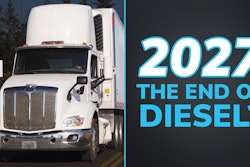Energy and the environment are the issues that will redefine the trucking industry over the next decade. That’s what Chris Spear, president and CEO of the American Trucking Associations, told a room full of industry experts Wednesday at the annual Cummins-Meritor and Pressure Systems International fleet technology event held in San Antonio, Texas.
But he said the timeline the industry has placed on the adoption of battery electric vehicles (BEV) and to achieve zero emissions are “completely unachievable.”
“It takes time. We're not going to get there starting in 2030. We're not going to meet that by 2035. It ain't gonna happen,” Spear said, "and when it fails, it's not only going to be embarrassing, it's going to cost a lot of people their jobs. To me, that's just unacceptable.”
Spear and North American Council for Freight Efficiency (NACFE) Executive Director Mike Roeth called for a sequencing method because “we do not have the infrastructure in place to charge,” Spear said. “Let's just say we do. Rainbows and unicorns, it's all there; you can charge anywhere you want to … Where's the power going to come from?”
According to the American Transportation Research Institute, it would take 40% more capacity on the grid to charge every car and truck currently on the road. But our mineral sources – China and the Congo – are not reliable long term, and it would take 10 years of domestic mining for those minerals to reach market, Spear said.
Aside from the lack of infrastructure and power, Spear said operational parity is a major barrier to BEV adoption. It takes 15 minutes to fill a diesel to go 1,200 miles, while it takes six or more hours, depending on the batteries, to charge for a 250-mile trip.
That’s why BEV needs to start with vans and step vans, then box trucks, then regional haul/return-to-base operations before long haul can be considered, Roeth said. Spear said the common-sense sequence is starting with vehicles like garbage trucks and school buses and building the infrastructure and power grid around that before expanding.
And in the meantime, look at what NACFE has dubbed “the messy middle.” Roeth said electricity and hydrogen are the long-term solutions, but there isn’t a direct path there from diesel.
“Start with battery electric trucks. I know that's not practical for a lot of the industry. As fuel cells start to emerge, think about fuel cells. We're not there yet. It'll be a while before we really have fuel cells available for much of the market,” he said. “So look at these things in the middle. Consider natural gas. Consider these renewable fuels. Maybe hybrids, maybe not. Then lastly, what I would suggest is … if it makes sense for you to continue to burn petroleum diesel for a long time or forever … train your drivers on better fuel economy. Think about how you’re setting the parameters on the engine around cruise control and other operational characteristics, and improve your MPG.”
BEV doesn’t make sense for much of the industry right now, not only because of operational parity but also because of cost parity, Spear said. BEVs cost three to four times more than a brand-new diesel truck.
Spear said one of the biggest no brainers that would lower emissions is to lower costs by cutting the federal excise tax, which adds 12.5% – about $25,000 on average – on every truck and trailer purchased.
“This is an arcane, ridiculous tax – one of about a dozen that was put in place for trench warfare … and it's the only one that remains,” Spear said. “Imagine if we repeal that how much good would come from that one decision by Congress.”
It would free up money to buy BEVs. Or it could simply be used for maintenance and repair, new equipment and technologies, and safety and training – all of which can help improve sustainability.
“Fifty-three percent of trucks operating in California today are 2010 or older. If you repeal that FET and over 10 years put the latest greatest diesels out there, you will reduce emissions in California by 83%,” he said. “That's a staggering accomplishment. It's a no brainer. If the goal is to reduce emissions, repealing FET is the smartest thing you can do.”
He said there is currently bipartisan support to repeal the FET in both the house and senate, so he is hopeful. He also said he is optimistic for the economic outlook of 2024.
“Let the economy function as it is,” he said. “We will always find a way to adapt within it, and I think it has the ingredients for a good year, so I'm optimistic.”













